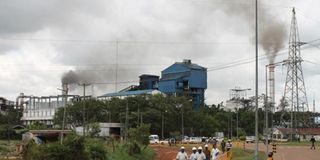Breaking News: At least 10 feared to have drowned in Makueni river
Sharp drop in sugar imports fails to stir farmers and millers

Mumias Sugar Company has the highest raw material requirements in the country because of its diversification into power co-generation, ethanol distillation and water purification projects. Investors who bought the stock at its peak are feeling the effects of gross mismanagement and industry adversities. PHOTO | ISAAC WALE | FILE
What you need to know:
- Sugar produced in the country increased by 38 per cent to 654,209, perhaps underlining the oversupply of the commodity in the market, hence the poor prices.
- A cane census conducted between January and March showed that yields had dwindled by 2.5 per cent.
Farmers and factories are yet to benefit from a drop in sugar imports, even as calls to ban the business so as to safeguard the local industry increase.
The sugar industry is yet to feel the impact of reduced imports, with a report by the Kenya Sugar Board showing a significant decrease in ex-factory sugar prices.
The report from the industry regulator for the 2013/14 financial year says total sugar imports decreased by 23 per cent from a high of 226,011 tonnes last year to 172,924 tonnes.
The report shows that ex-factory prices of sugar over the same period dropped by 24 per cent to Sh74,420 per tonne, down from Sh99,500 in 2012/13.
Imports have for long been blamed for crippling the sector by retailing at much lower prices than local sugar, thus pushing local factories out of business.
Cane farmers, like the millers, also did not reap from the decreased imports after the sector experienced an overall 10 per cent drop in cane prices.
A drop in prices is usually indicative of a struggle by millers to move their stock, owing to an oversupply in the market.
“South Nyanza Sugar Company offered the best cane prices to farmers, at Sh3,567 per tonne, while Soin Sugar Company paid the lowest price, at Sh3,168,” said the regulator.
Increased surveillance and low production resulted in decreased imports from Comesa Free Trade Area and East Africa Community countries by more than 50 per cent.
The EAC provided 3,102 tonnes, a sharp drop from 16,842 tonnes in 2012/13, while Comesa supplied 48,802, compared with 86,230 the previous the year.
POOR PRICES
Sugar produced in the country increased by 38 per cent to 654,209, perhaps underlining the oversupply of the commodity in the market, hence the poor prices.
“Sugar mills reported increased sugar production in July 2013 to June 2014, compared with the same period last year, except for Nzoia and Soin,” said the Kenya Sugar Board.
State-owned Nzoia Sugar Company’s decrease was ascribed to factory closure in April and May for maintenance, while reduction at Soin was due to unscheduled factory shut-downs caused by breakdowns.
The industry regulator has, however, sent a warning to all millers in its 2013/14 and 2014/15 sector outlook over potential cane shortage that may cause turbulence in the industry.
A cane census conducted between January and March showed that yields had dwindled by 2.5 per cent despite enhanced cane development programmes by millers.
The board attributes the decrease to disillusionment by farmers over delayed and or poor returns, resulting in withdrawal from cane farming.
“Cane available for crushing in the next financial year will be 7,574,850 tonnes, against a requirement of 8,302,000 tonnes. The industry is projected to have a deficit in supply,” warned the regulator.
Listed company Mumias Sugar, which is the largest miller in Kenya, is projected to bear the brunt of the deficit, along with Kisumu-based private miller Kibos.
Mumias Sugar has the highest raw material requirements in the country because of its diversification into power co-generation, ethanol distillation and water purification. Poor cane supply can greatly hurt the firm’s revenue streams.
The miller has been making losses since 2012, with the management blaming the dismal performance on acute scarcity of sugar cane, thanks largely to poaching.
In the six months to December 2013, it reported a loss of Sh73.4 million, an improvement from the Sh1.67 billion loss it recorded in the full year to June 2013.
Kenya has less than eight months to the expiry of a one-year sugar safety extension window granted by Comesa earlier in the year.
It is expected that by February 2015, sugar imports from Comesa nations — considered low-cost producers — will have limitless access to Kenya, increasing competition for local millers.





